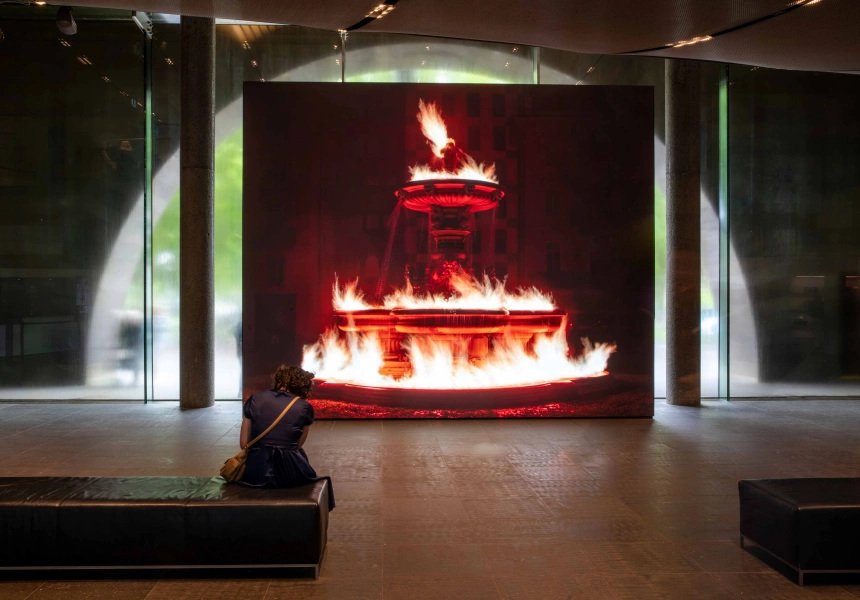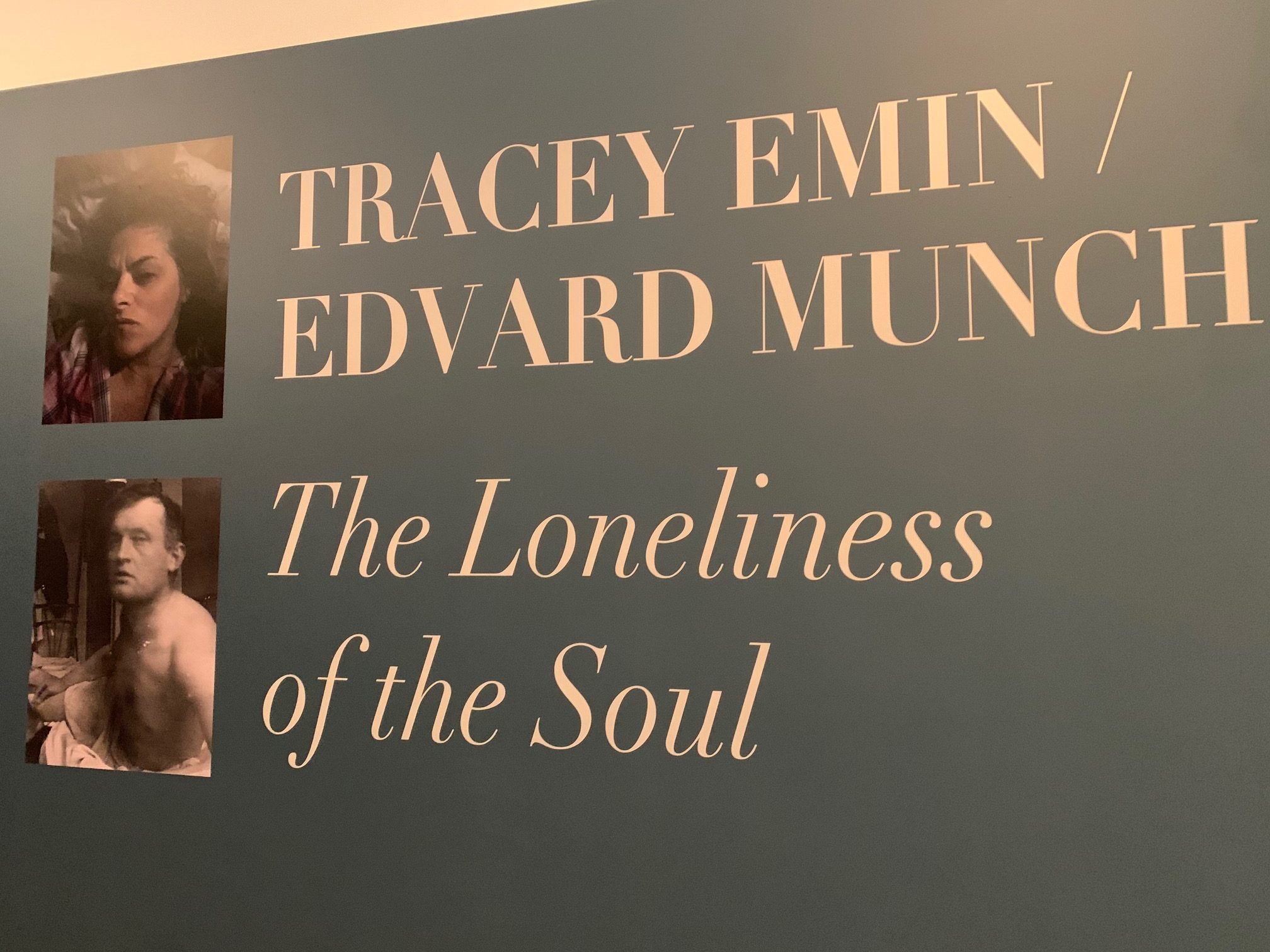Finally, during the third iteration of the NGV Triennial, I’ve realized that the appreciation of this exhibition is a matter of mindset. If you go in with an open mind, keen to see what people are getting up to these days then you may be pleasantly surprised. But be warned - we are living through troubling times so expect to see some troubling work. The NGV magazine tells us that the Triennial is anchored in three themes; Matter, Magic and Memory. Nearly 100 works from over 30 countries have been assembled in this exhibition with overtones encompassing race relations, climate crisis, AI and war.
Julian Charriere, And beneath it all flows liquid fire (NGV)
Australian Design Review tells us that the theme of ‘magic’ represents the influence of spirituality on constructing an understanding of the world around us, whereas ‘matter’ symbolises how nature and materials shape human culture. The exhibition’s theme of ‘memory’ will illuminate how the histories of people, places and objects continue to impact our contemporary world.
As with the Melbourne Now exhibition several months earlier, part of the Triennial has its own dedicated spaces whilst other parts are inserted into the permanent collection.
For some reason, the thoughts of the late Robert Hughes came to my mind when viewing this exhibition. “The Age of Anxiety” was the title Hughes gave to the final episode of his 1996 TV series “American Visions”. We are still living with this anxiety today although the focus has shifted from the aftermath of the disastrous Vietnam War to climate change, the loss of habitat and species and the realization that our natural resources are not infinite. Apparently it’s the intention of many artists participating in the Triennial to address these issues.
Ashley Jameson Eriksmoen, ‘Fell’, timber salvaged from furniture (Geoff Harrison)
The work “Fell” clearly has environmental and sustainability overtones, but visually it’s stunning. Eriksmoen is a designer/artist who has won a number of awards including for furniture design.
Tracey Emin, 'Love Poem For CF', 2007 (NGV)
Robert Hughes had real issues with what he regarded as preachy, single issue ‘art’ where “victim credentials can account for more than aesthetic achievement”. So true, and this came to my mind whilst viewing this work my Tracey Emin - and it’s a recent NGV acquisition.
Agnieszka Pilat, 'Hetrobota 2023' (Geoff Harrison)
Pilat trained these Boston Dynamics robot dogs to behave in distinctly different ways. Basia is the oldest, the most serious and the introvert; Bunny is the narcissist and the artist while Vanya is the protector, monitoring what’s going on. What freaks me out is the thought that in a few years time we will look back at this work and think how primitive it was, given the relentless advances in technology towards - who knows where?
SMACK, 'Speculum' (Youtube)
This is meant to be a digital remake of Hieronymus Bosch’s renaissance masterpiece “Garden of Earthly Delights” where ‘the banal temptations of modernity, consumerism and the obsession with technology take the place of the Devil’s apple offered to Adam and Eve, which led to their downfall.’ As a friend pointed out, there is no sex and gore in this remake - I wonder why?
Franziska Furter, 'Liquid Skies/Gywrynt' & 'Haku', climate carpet and glass beads (Artshub)
The carpet depicts multiple satellite images of storms with a shower of glass beads overhead. This installation is cleverly juxtaposed against wild seascapes painted by J W M Turner and others. Furter draws constant inspiration from the weather for her work. “It forces me to become aware of what is now. As a recurring theme, the weather constantly shapes and changes my work as it constantly shapes and changes the world.” She is a great fan of the BBC’s Shipping Forecast which has been regularly broadcast since 1861.
Flora Yukhnovich, ‘A Taste Of A Poison Paradise’, oil on canvas, 160 x 275 cm (Hauser & Worth)
This work takes its name from the 2003 Brittany Spears hit song “Toxic”. Spears was arguably at the peak of her career back then, but shortly afterwards her life imploded with mental health issues engulfing her. So are we looking at the aftermath of an explosion destroying a beautiful still life in the tradition of the Dutch masters?
Osamu Mori " 3MMM-Rivalry", Camphor laurel, (Geoff Harrison)
The human figure has been carved into a 120 year old camphor tree. Traditionally, camphor has been employed for its aromatic scent as an embalming fluid, and thus this work could be seen as representing the healing powers of nature.
Jessica Murtagh, "Modern Relic IV, All In This Together, Apart", sandblasted & engraved glass (Geoff Harrison)
The NGV tells us that Murtagh draws inspiration from ancient Athenian ceramic amphoras known for their depiction of scenes from everyday life. Here we see individuals wearing face masks queuing at a Centrelink office.
Glenn Brown "After Greuze"," After Rembrandt", "After De Gheyn II/Greuze", etching (NGV)
The ancient art of printmaking as not been overlooked in this exhibition either. Brown appropriates historical art in his paintings and sculptures and in recent years has extended his conceptual concerns to drawing and printmaking.
Fernando Laposse, "Avocado Leather Cabinet", avocado skin & walnut (Geoff Harrison)
This is part of Laposse’s Conflict Avocado series where he exposes the devastating impact the corrupt and violent avocado industry is having on forest ecosystems in Mexico, and on the lives of those who depend on it.
The Community of Maningrida, Arnhem Land, "Maningrida Fish Fence", Pandanus & natural dyes (Geoff Harrison)
The tradition of weaving goes back a long time in the community of Maningrida. The Burarra women of Maningrida use natural materials such as pandanus leaves, kurrajong and various bark fibres to produce their work.
Azuma Makoto, "Block Flowers", flowers in resin, (Geoff Harrison)
130 of these boxes have been mounted around a digital video piece titled “Drop Time” depicting the life cycle of flowers in hyper speed. “A mark of celebration and sorrow, flowers have historically been used to acknowledge life, death and the passing of time”.
"Megacities Project", 10 photographers’ images across 19 suspended screens (Geoff Harrison)
This work was commissioned by the NGV where leading photographers were engaged to capture the environment of 10 mega cities - defined as having more than 10 million inhabitants. In the 1950’s there were only 2 of them, by 2022 there were more than 30 - with half of them to be found in Asia.
Any gripes? A few including the paintings of Prudence Flint which leave me cold; the Yoko Ono installation “My Mommy Is Beautiful” has taken well over a decade to get here and we’ve definitely been short-changed on the work of artist/prankster Maurizio Cattelan. His banana taped to a wall is hardly the highlight of his career. I would have much preferred his fully-functioning 18 karat gold toilet titled “America”.
Many of the works in this exhibition were commissioned by the NGV and will join the gallery’s permanent collection. Overall, I’m inclined to give this exhibition the thumbs up - as per the sculpture outside the gallery entrance.
References;
National Gallery of Victoria
Artshub
Hauser & Worth
Australian Design Review

















